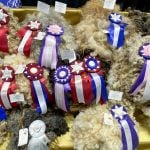EDMONTON – Despite low lamb prices in the past few months, Vern Gleddie believes raising sheep can still be financially rewarding.
“If you have a lot of energy and time, sheep will reward the effort,” said Gleddie.
The key to making money is keeping costs low, said Gleddie, who raises sheep on a half section of land just outside of Edmonton.
“It all depends on how well you can manage costs and the marketplace.”
Gleddie is always searching for low-cost feed for his 200 ewes and feeder lambs. He said at one time he felt an obligation to do everything “right,” but realized right doesn’t always make money.
Read Also

Short rapeseed crop may put China in a bind
Industry thinks China’s rapeseed crop is way smaller than the official government estimate. The country’s canola imports will also be down, so there will be a lot of unmet demand.
“Anyone in sheep cannot justify expensive facilities or feeding facilities, not even people who market thousands of lambs,” said Gleddie, whose family has been in the sheep business for two generations.
A mixture of cattle and sheep was not uncommon when Gleddie’s father began raising sheep in the 1920s in southeastern Alberta. But back then, farmers had access to thousands of acres of free range. With long distances between water holes, sheep were more suited than cattle to surviving the harsh environment. Sometimes the sheep would go two days before finding water, he said.
With the introduction of large earth-moving equipment, more wells and sloughs were built and the land became more hospitable for cattle.
“When the cattle came in, the sheep went out.”
At the peak the family had 3,000 ewes grazing on 50 sections of land.
The land, near Tilley, Alta., was a mixture of CP Rail land and government land that was abandoned by settlers who had been enticed to the area with stories of fertile farmland.
The flock was reduced in the 1960s when the family’s spring lambing range was taken away for irrigation.
Gleddie said he never wanted to wander far from the southern Alberta ranching area. He enjoyed the smell of sage, the sight of cactus in flower and watching the burrowing owls.
“I was very much attached to the semi-arid prairie.”
But there was no opportunity in the family business so he went to university, earned a masters in animal science and became the province’s first full-time sheep specialist.
“I never really wanted to do anything more than ranch,” said Gleddie, who settled in some of the province’s most fertile land outside Edmonton where he has become a mainstay in the sheep business.
At one time, he had 750 ewes, but has reduced his flock to 200 ewes and a few hundred feeder lambs that he buys at auction throughout the year.
“The real killer is lambing time. It takes a lot of attention and effort.”
Between his own lambs and what he buys, he sells 1,000 fat lambs a year.
A key selection criteria to keeping or culling a ewe is if it is able to produce and raise triplets, another way to increase profits without increasing expenses.














